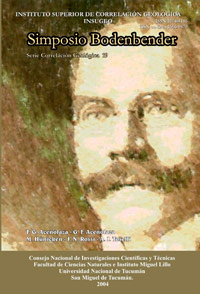Serie Correlación Geológica 19
Los cuerpos graníticos del Nevado del Famatina: vigencia de las observaciones realizadas por Bodenbender un siglo atrás
Descargar trabajo en formato PDFResumen
LOS CUERPOS GRANÍTICOS DELNEVADO DEL FAMATINA: VIGENCIA DE LAS OBSERVACIONESREALIZADAS POR BODENBENDER UN SIGLO ATRÁS. Como parte de sus investigaciones realizadas a principios del siglo XX, en la Provincia de La Rioja, Bodenbender describe al “Nevado del Famatina” y señala que las rocas eruptivas se reconocen en tres zonas más o menos paralelas”. “La primera está formada por el cristalogranito de dos micas que compone la cadena Chilecito-Paimán, vinculado orográficamente con la sierra de Famatina, pero geológicamente con la de Velasco. La segunda zona está constituida por rocas que se acerca ora a la sienita cuarcífera ora a la diorita cuarcífera que pasa en transición a granito biotítico y que afloran en el área central. La tercera zona abarca la sierra encumbrada con sus contrafuertes occidentales y se caracteriza por la presencia de granitos, granito-dioritas, con predominancia de aplitas y en la que son importantes las dioritas cuarzosas, gabro anfibólico, además de lamprófiros. Para evaluar la validez de las observaciones realizadas por Bodenbender, se reseñan las características del magmatismo famatiniano tratadas por diversos autores recientemente, y así es posible reconocer la actualidad de la zonas definidas por Bodenbender, especialmente en los aspectos relacionados con las características petrográficas de los intrusivos. Los estudios posteriores, en particular los más recientes, en los que se hacen hincapié en los rasgos geoquímicos, geocronológicos y geotectónicos marcan algunas diferencias en cuanto a esta zonación y caracterización, debidos especialmente al mayor detalle y complejidad de los mismos, por lo que es necesario resaltar aún hoy en día la precisión de las observaciones realizadas hace casi un siglo por este autor.
Abstract
THE GRANITES OF THE FAMATINA: THE VALIDITY OF BODENBENDER OBSERVATIONS ONE CENTURY AGO. As part of his research carried out at the beginning of the XX century, in the Province of La Rioja, Bodenbender describes to the Nevado de Famatina and points out that the granite-dioritic intrusive is recognized in three almost parallel areas The first area is formed by the two micas cristalogranito recognized in the Ranges of Chilecito-Paimán that orographicly is linked with Famatina Range, but by its geology with Velasco Range. The second area is defined by Bodenbender as constituted by quartz sienite-quartz diorite and by biotitic granite that crops out in the central area between the granites of Paimán and Cerro Toro. The third area correspond to the peak area and western side of the range and it is characterized by Bodenbender by the presence of granites, granite-diorites, with aplites predominance and quartz diorites, anphibolic gabbro and lamprophyres. At the present time, these three areas defined by Bodenbender, conserve their validity, especially in the aspects related with the petrographic characteristics of the intrusives. To evaluate the current validity of the observations carried out by Bodenbender at the beginning of the XX century, Famatinian magmatism features recently pointed out by diverse authors are presented and in this way is possible to recognize that these three areas defined by Bodenbender, conserve the validity, especially in the aspects related with the petrographic characteristics of the intrusives. Later studies, in particular the most recent, focus in geochemical, geochonology and geotectonic features mark some differences with this zonation and characterization due especially to the major detail and complexity, for this is necessary point out the precision of the observations carried out one century ago by this author






